 Movie stars were always willing to give each other a hand. 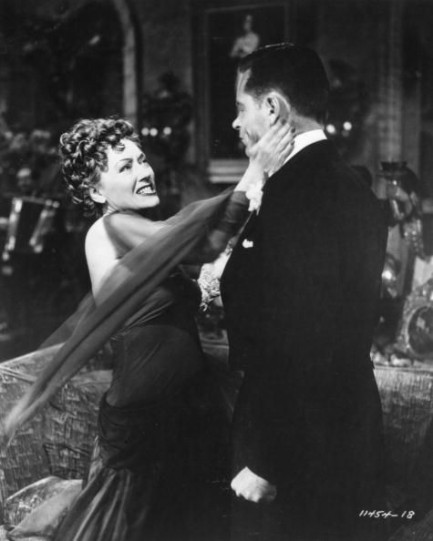
Once again we've been struck, so to speak, by the sheer number of cinema promo images featuring actors and actresses pretending to slap each other. They just keep turning up. The above shot is more about the neck than the face, but it still counts, as Gloria Swanson slaps William Holden in 1950's Sunset Boulevard. Below we have a bunch more, and you can see our previous collection at this link. Since we already discussed this phenomenon we won't get into it again, except briefly as follows: pretend slaps, film is not reality, and everyone should try to remember the difference. Many slaps below for your interest and wonder. 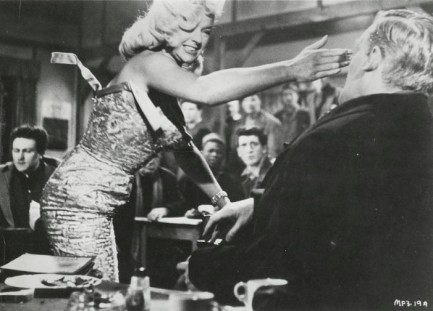 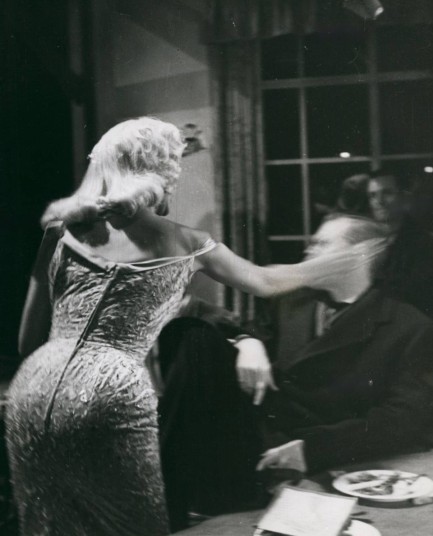 Diana Dors smacks Patrick Allen blurry in 1957's The Long Haul. Diana Dors smacks Patrick Allen blurry in 1957's The Long Haul.
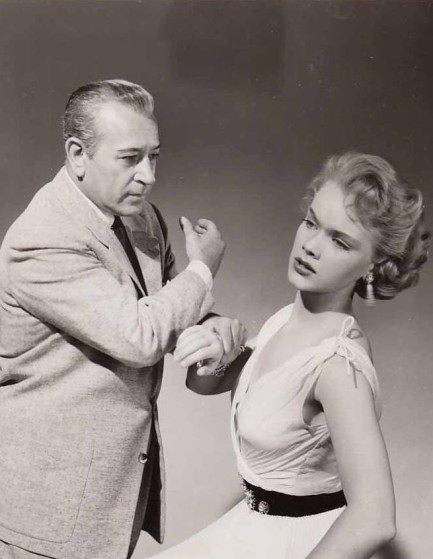 Mob boss George Raft menaces Anne Francis in a promo image made for 1954's Rogue Cop. Mob boss George Raft menaces Anne Francis in a promo image made for 1954's Rogue Cop.
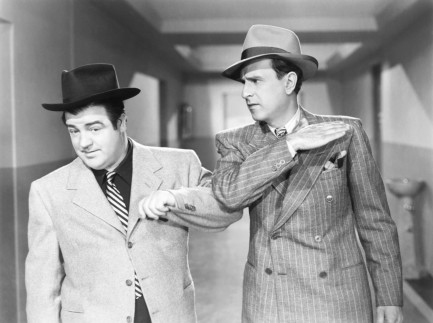 Bud Abbott gets aggressive with Lou Costello in 1945's Here Come the Co-Eds. Bud Abbott gets aggressive with Lou Costello in 1945's Here Come the Co-Eds.
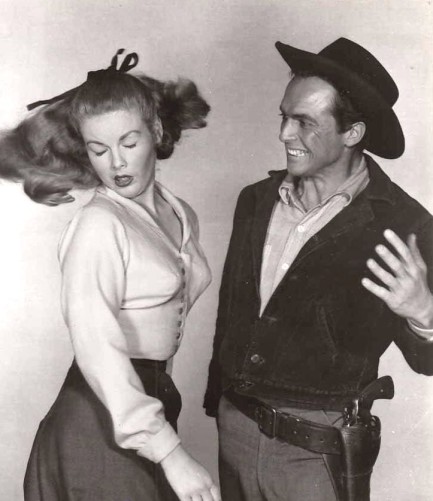 Jo Morrow takes one from black hat Jack Hogan in 1959's The Legend of Tom Dooley. Jo Morrow takes one from black hat Jack Hogan in 1959's The Legend of Tom Dooley.
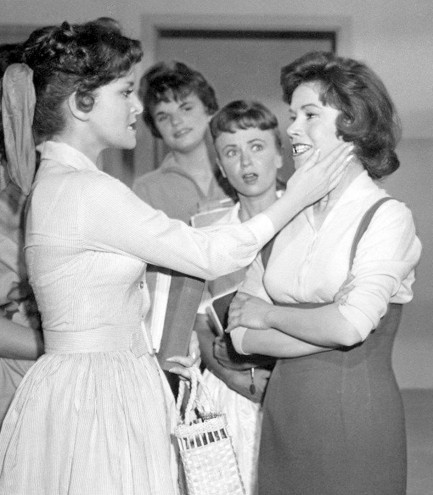 Chris Robinson and Anita Sands get a couple of things straight about who's on the yearbook committee in Diary of High School Bride. Chris Robinson and Anita Sands get a couple of things straight about who's on the yearbook committee in Diary of High School Bride.
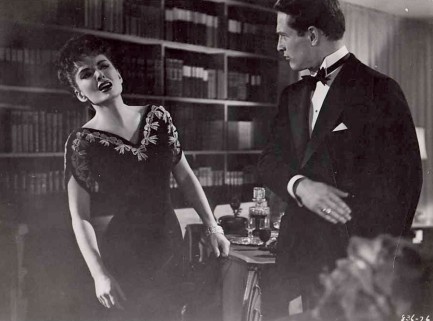 Paul Newman and Ann Blyth agree to disagree in 1957's The Helen Morgan Story. Paul Newman and Ann Blyth agree to disagree in 1957's The Helen Morgan Story.
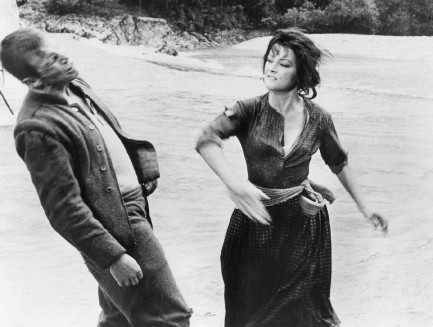 Verna Lisi shows Umberto Orsini who gives the orders in the 1967 film La ragazza e il generale, aka The Girl and the General. Verna Lisi shows Umberto Orsini who gives the orders in the 1967 film La ragazza e il generale, aka The Girl and the General.
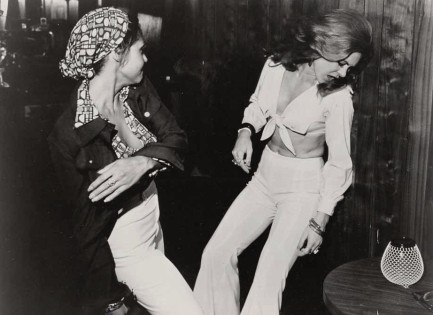 What the fuck did you just call me? Marki Bey slaps Betty Anne Rees loopy in the 1974 horror flick Sugar Hill. What the fuck did you just call me? Marki Bey slaps Betty Anne Rees loopy in the 1974 horror flick Sugar Hill.
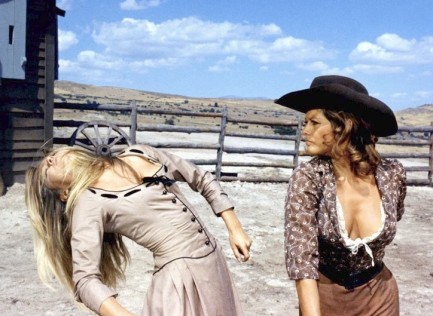 Claudia Cardinale slaps (or maybe punches—we can't remember) Brigitte Bardot in the 1971 western Les pétroleuses, known in English for some reason as The Legend of Frenchie King. Claudia Cardinale slaps (or maybe punches—we can't remember) Brigitte Bardot in the 1971 western Les pétroleuses, known in English for some reason as The Legend of Frenchie King.
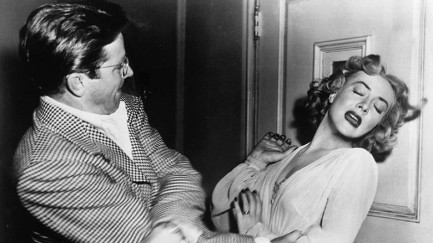 Audrey Totter reels under the attentions of Richard Basehart in 1949 Tension. We're thinking it was probably even more tense after this moment. Audrey Totter reels under the attentions of Richard Basehart in 1949 Tension. We're thinking it was probably even more tense after this moment.
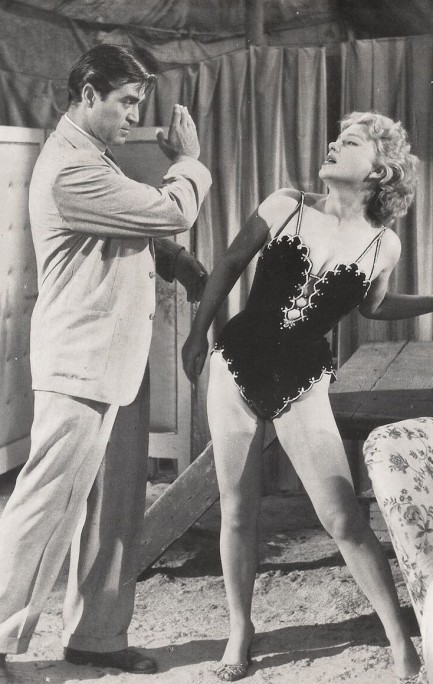 Anne Baxter tries to no avail to avoid a slap from heel Steve Cochran in 1954's Carnival Story. Anne Baxter tries to no avail to avoid a slap from heel Steve Cochran in 1954's Carnival Story.
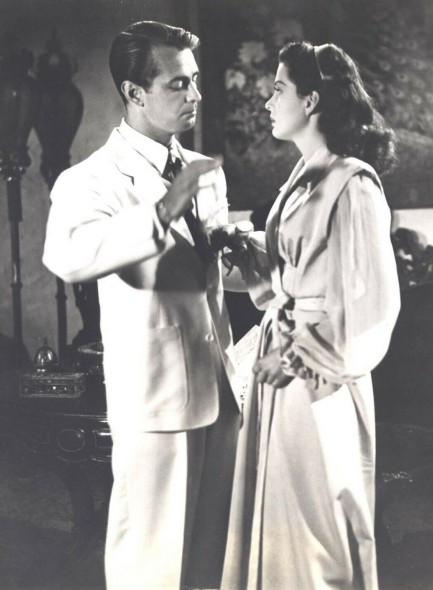 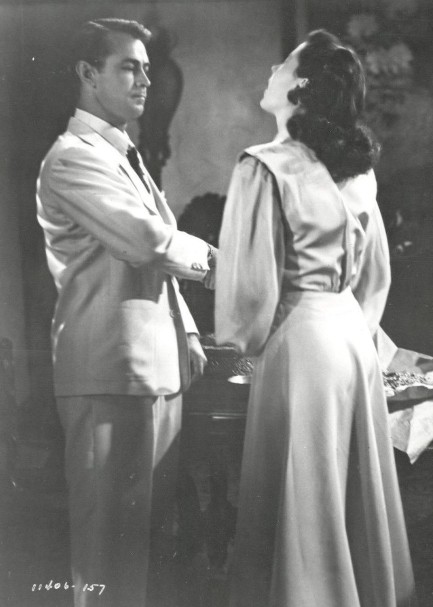 Though Alan Ladd was a little guy who Gail Russell probably could have roughed up if she wanted, the script called for him to slap her, and he obeyed in the 1946 adventure Calcutta. Though Alan Ladd was a little guy who Gail Russell probably could have roughed up if she wanted, the script called for him to slap her, and he obeyed in the 1946 adventure Calcutta.
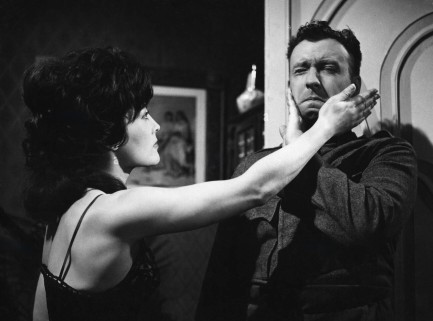 Peter Alexander guards his right cheek, therefore Hannelore Auer crosses him up and attacks his left in 1964's Schwejk's Flegeljahre, aka Schweik's Years of Indiscretion. Peter Alexander guards his right cheek, therefore Hannelore Auer crosses him up and attacks his left in 1964's Schwejk's Flegeljahre, aka Schweik's Years of Indiscretion.
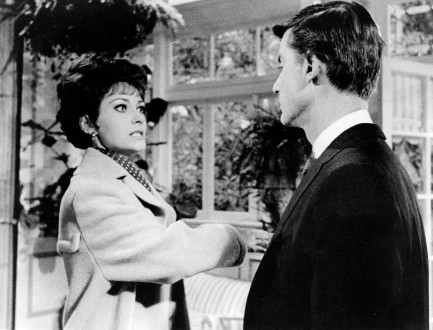 Elizabeth Ashley gives Roddy McDowall a facial in in 1965's The Third Day. Elizabeth Ashley gives Roddy McDowall a facial in in 1965's The Third Day.
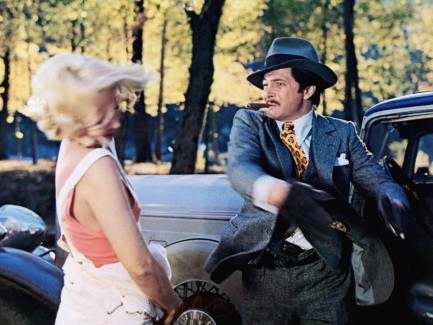 Tony Anthony slaps Lucretia Love in 1972's Piazza pulita, aka Pete, Pearl and the Pole. Tony Anthony slaps Lucretia Love in 1972's Piazza pulita, aka Pete, Pearl and the Pole. 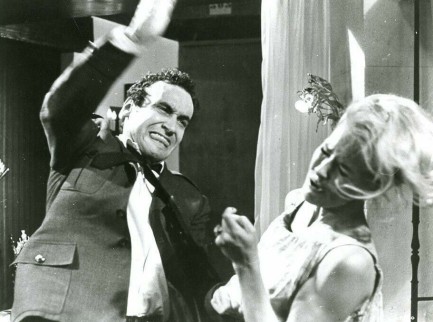 André Oumansky goes backhand on Lola Albright in 1964's Joy House. André Oumansky goes backhand on Lola Albright in 1964's Joy House.
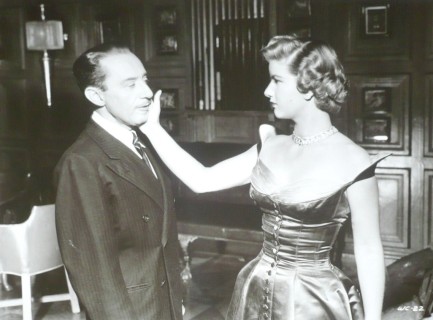 Frank Ferguson catches one from Barbara Bel Geddes in the 1949 drama Caught. Frank Ferguson catches one from Barbara Bel Geddes in the 1949 drama Caught.
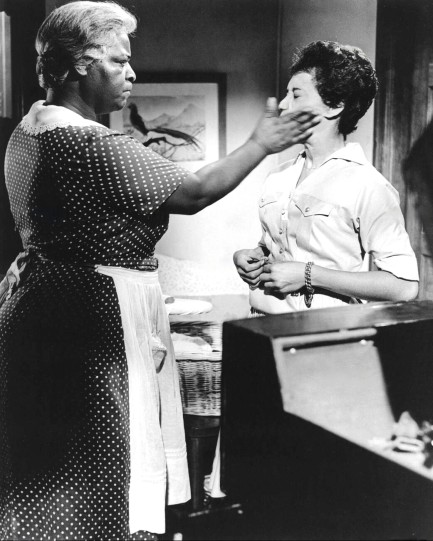 This looks like a real slap, so you have to credit the actresses for their commitment. It's from 1961's Raisin in the Sun and shows Claudia McNeil rearranging the face of Diana Sands. This looks like a real slap, so you have to credit the actresses for their commitment. It's from 1961's Raisin in the Sun and shows Claudia McNeil rearranging the face of Diana Sands.
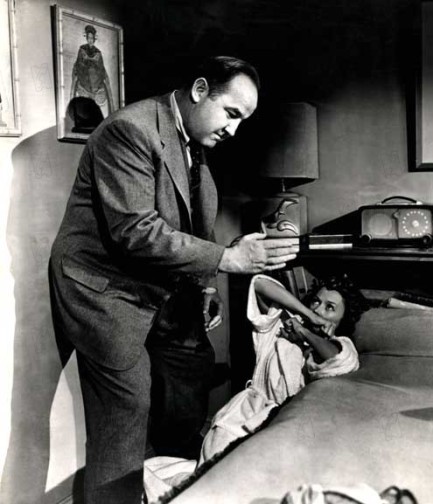 Gloria Grahame finds herself cornered by Broderick Crawford in 1954's Human Desire. Gloria Grahame finds herself cornered by Broderick Crawford in 1954's Human Desire.
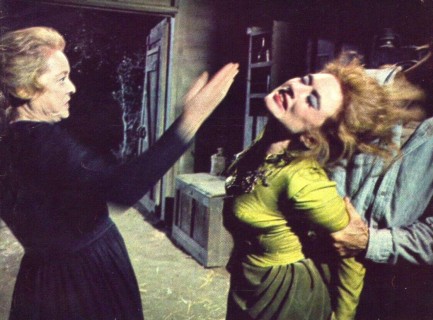 Bette Davis, an experienced slapper and slappee, gets a little assistance from an unidentified third party as she goes Old West on Amanda Blake in a 1966 episode of Gunsmoke called “The Jailer.” Bette Davis, an experienced slapper and slappee, gets a little assistance from an unidentified third party as she goes Old West on Amanda Blake in a 1966 episode of Gunsmoke called “The Jailer.”
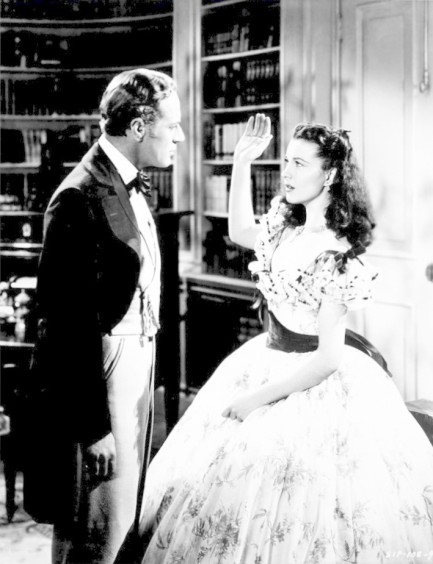 There are a few slaps in 1939's Gone with the Wind, so we had our pick. We went with Vivien Leigh and Leslie Howard. There are a few slaps in 1939's Gone with the Wind, so we had our pick. We went with Vivien Leigh and Leslie Howard.
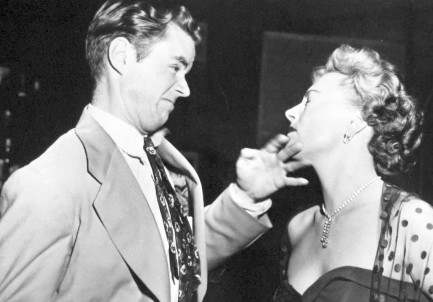 Virginia Field takes one on the chin from Marshall Thompson in Dial 1119. Virginia Field takes one on the chin from Marshall Thompson in Dial 1119.
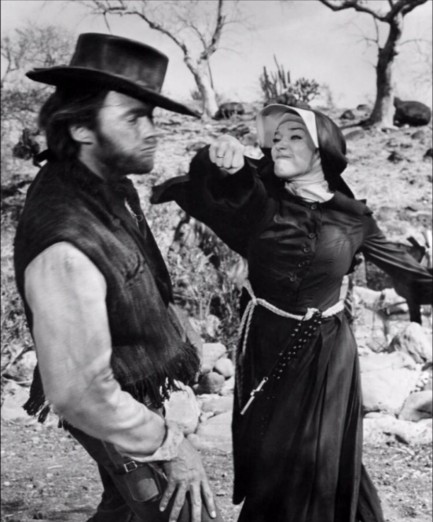 Clint Eastwood absorbs a right cross from nun Shirley MacLaine in 1970's Two Mules for Sister Sara. Clint Eastwood absorbs a right cross from nun Shirley MacLaine in 1970's Two Mules for Sister Sara.
 Round and round she goes. Where she stops nobody knows. 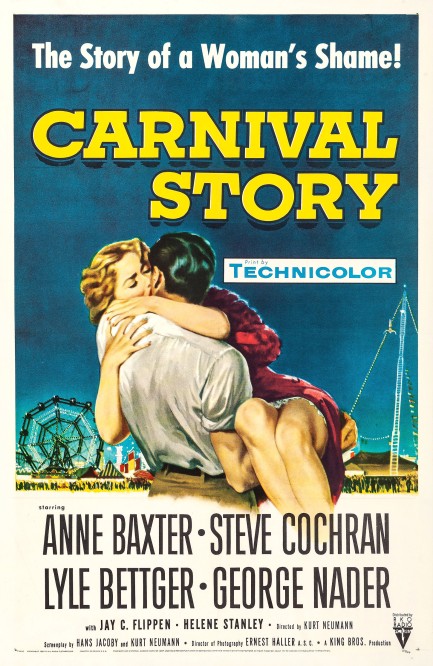
We like books set in carnivals. They've been among our most interesting reads. So we figured a movie set in a carnival—Carnival Story, with Anne Baxter and Steve Cochran—was a natural. We gave it a look and it's an above average drama about how Baxter becomes a high diver in a Munich carnival and makes a big splash, but has relationship issues that threaten to derail her career and life. Her main problem is Cochran. He lies, he cheats, and he steals, but she just can't quit him, even though her diving partner Lyle Bettger is totally devoted to her. Even after she marries Bettger she can't keep her hands off Cochran. This can only end badly. And by badly we mean violence and death.
Carnival Story is one of those movies with an unspoken sexual subtext. Why would Baxter let Cochran mistreat her again and again? Well, because he gives her something no other man can. Though it couldn't be shown onscreen we can understand that something to be sexual passion. Bettger, and later George Nader, are both devoted to Baxter, and they're nice guys besides, but they're square. Cochran gets Baxter's loins all feverish. Portraying a woman trapped in this dilemma during Hollywood's age of censorship takes acting skill, and Baxter, an Academy Award and Golden Globe winner by this point, has plenty of that. Anything she's in is worth a watch. Carnival Story premiered today in 1954.
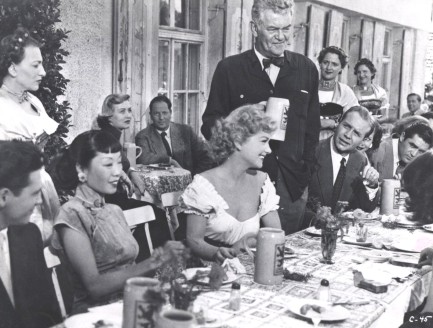 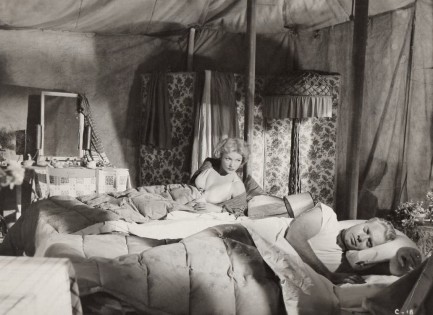 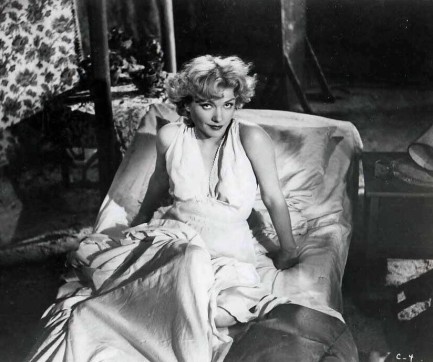 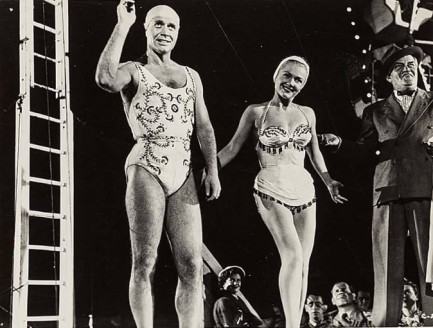 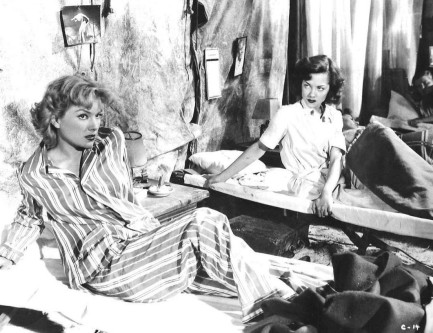 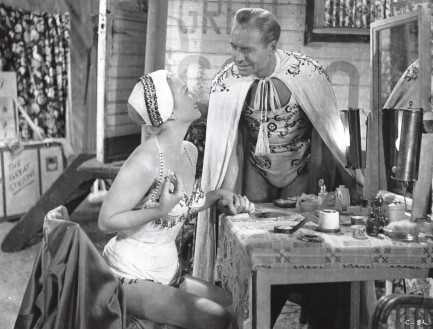 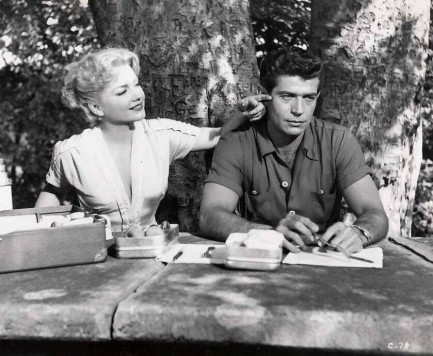 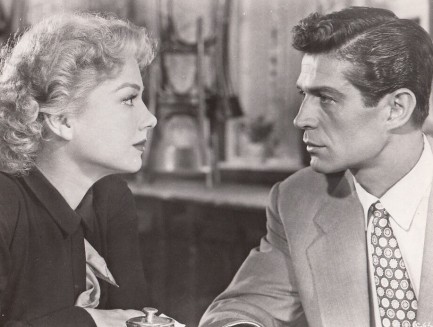 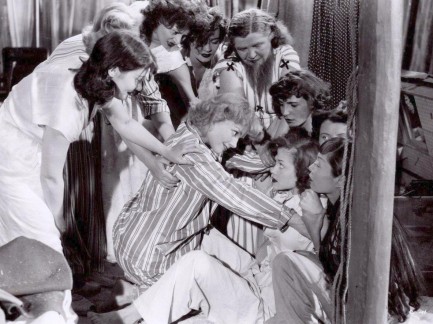 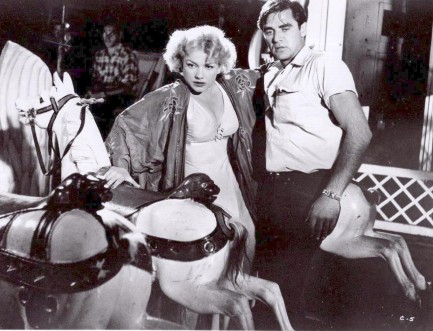 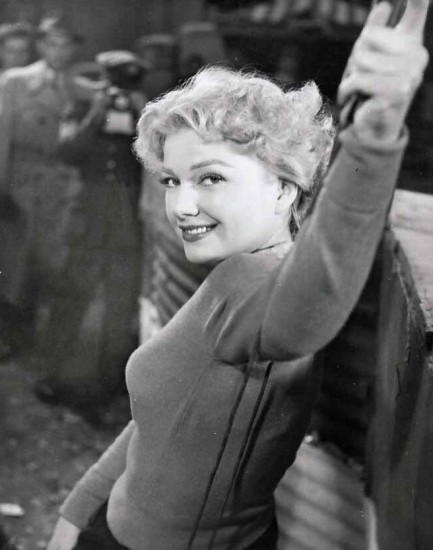 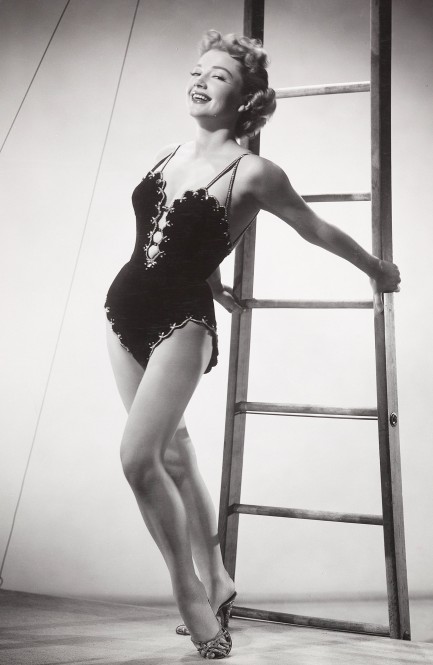 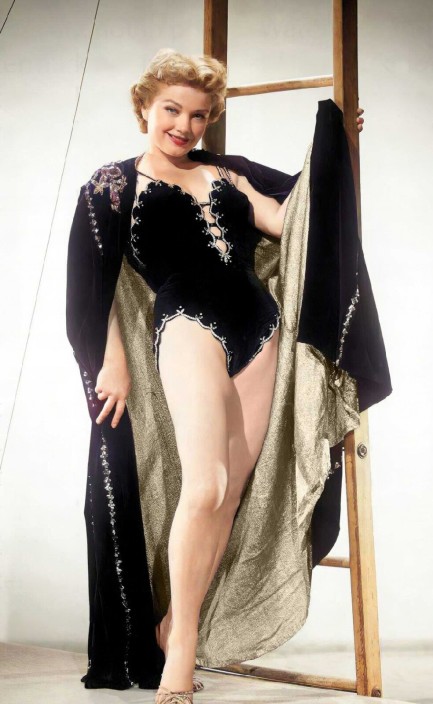
 He's watching your every move. 
Above is an Italian poster for the U.S. drama I, Mobster, a 1959 crime drama starring Steve Cochran that we discussed earlier this year. This promo is different from the U.S. version but still features lettering across Cochrane's eye—though the visual pun of having the actual letter “I” cross his eye is not achievable in Italian. But we still like this for its successful conveyance of mood, and we liked the movie enough to want to circle back to it. It's obscure, but pretty good. Plus it introduced us to Lita Milan.
 People try to put them down. 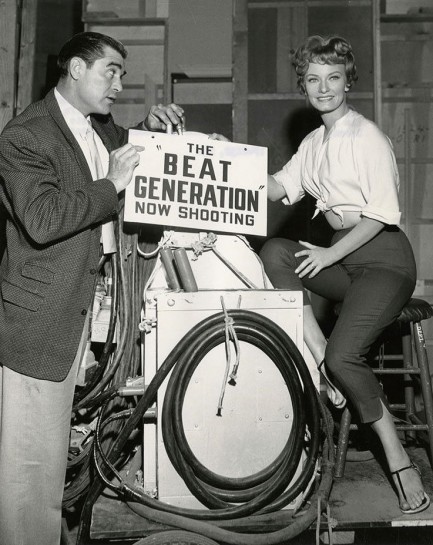
This photo was made to promote the 1959 drama The Beat Generation, and shows co-stars Steve Cochran and Fay Spain. The movie also starred the never-to-be-overlooked Mamie Van Doren. While you would think the movie deals with disaffected youth—and in some ways it does—it's largely about middle-aged detective Cochran trying to capture a serial rapist. We watched it five years ago. You can find out what we thought here.
 Damn it feels good to be a gangsta. 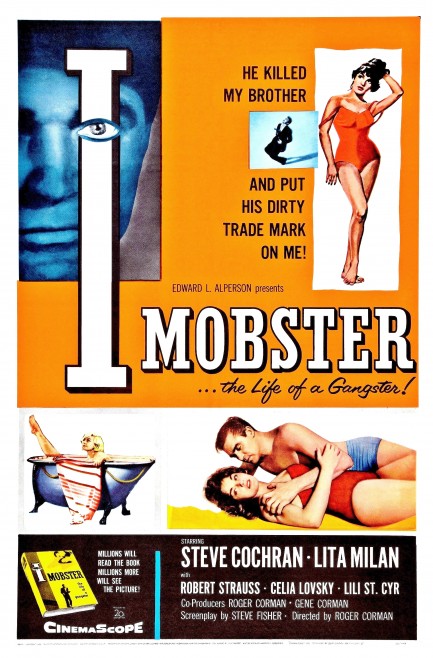
Above you see a U.S. promo poster for the crime drama I, Mobster, starring Steve Cochran in a rags-to-riches, innocence-to-corruption tale of a neighborhood kid who becomes a top man in the mob. The film was based on a 1951 novel of the same name published anonymously, but later identified as coming from the typewriter of Joseph Hilton Smyth, who also wrote Angels in the Gutter. The early plot driver is the mob's attempt to extort cash payments out of a powerful trade union. The plan is to offer services as “outside labor relations experts.” Cochran, as an ambitious footsoldier, expands the mob's vision, its areas of interest, and its profits. Pretty soon he's riding high, high, high. But it can't last. Of course not.
The film has the usual elements from this sub-genre: the round-the-way girl who offers redemption, the wailing mom who implores her son to go straight, the unimpressed father who eventually disowns him, the mob boss who's worried about his brash number two, and the ticking bomb—i.e. the seeds of destruction planted earlier. Here it's a little boy who knows Cochran killed a man. He grows up and becomes enfolded in the mob too, which places him in perfect position to blackmail Cochran. But Cochran is a tough cookie. It may take more than an ambitious twenty-something to bring him down, and it may be that the true seeds of destruction were planted earlier and elsewhere.
While the plot elements may be typical, the cast isn't. Cochran is a good, intense, underrated screen presence. Robert Strauss is perfect as Cochran's right hand man and steadying influence. The radiant Lili St. Cyr spices up the proceedings midway through with a burlesque routine. And the stunning Lita Milan is excellent as the good girl-turned-mob moll. In addition, the film is solidly directed. You often see I, Mobster, described as an early Roger Corman movie. Does a director's twentieth movie count as early? Corman knows what he's doing here. His road forked into the dark woods of schlock, but helming this production, with a low budget, he managed to squeeze out a solid b-mobster flick. There's nothing fresh in it, but with this cast freshness isn't needed. I, Mobster premiered today in 1959. 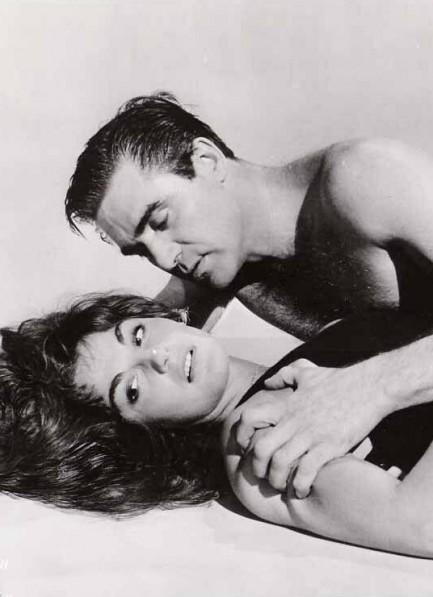 Don't play coy, baby. Would you rather be with a gangsta like me or some accountant from fuckin' donkeyville? Don't play coy, baby. Would you rather be with a gangsta like me or some accountant from fuckin' donkeyville? 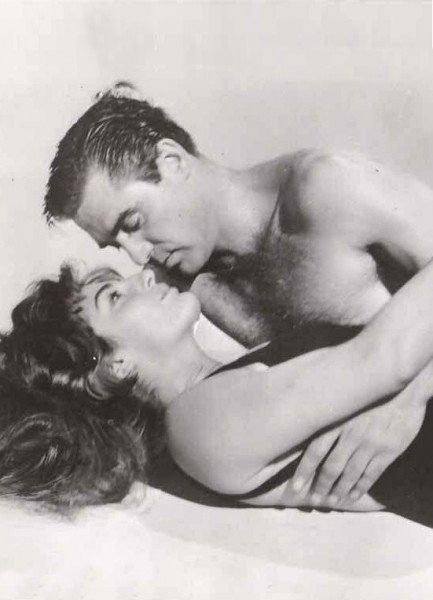 That's what I thought. That's what I thought.
 Our best option is to run as fast as we can. You can keep up with me okay in that floor length gown, right? 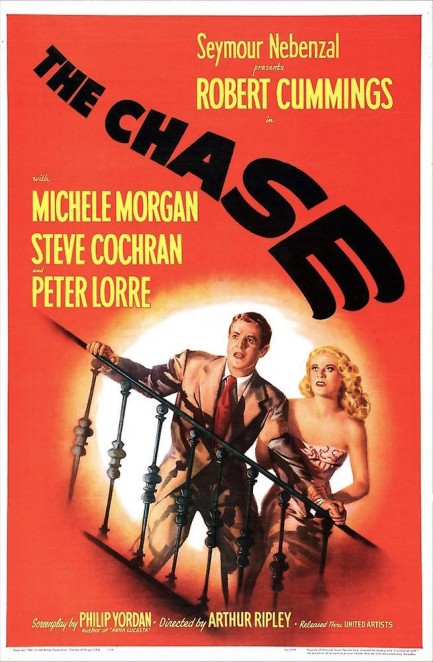 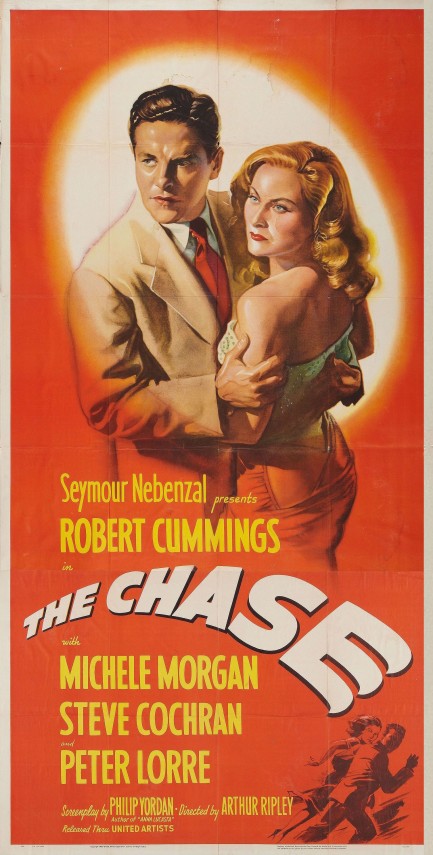
These two orange promos were made for The Chase, starring Robert Cummings as a down and out war vet and Steve Cochran as a Miami gangster. The film also has Peter Lorre as Cochran's henchman and Michèle Morgan as his wife. The plot set-up is simple. When Cummings finds a wallet packed with cash he returns it, though he's down on his luck. The wallet belongs to shady Cochran, who is impressed by Cummings' honesty and hires him to be a chauffeur. Pretty soon he's driving Morgan around too, which is a nice bonus. When she decides she wants to leave Cochran, she asks Cummings for help and he dreams up a scheme to escape by ship to Havana.
If you watch this you'll notice that Cummings is sedate, almost in a daze, but there are reasons for this that are revealed later. His escape plan does not—of course—come off without a hitch. Lorre figures it out and throws a monkey wrench in the works. That's not a spoiler. This is film noir, which means you know his initial plan won't work. But we won't reveal more. In our opinion, it would have been nice if the filmmakers had at least gotten some second unit shots from Havana to use, just a few street scenes or harbor shots, but no such luck. Though the movie has a backlot feel, some of the sets are pretty nice just the same. In the end it's worth seeing. It premiered in the U.S. today in 1946. 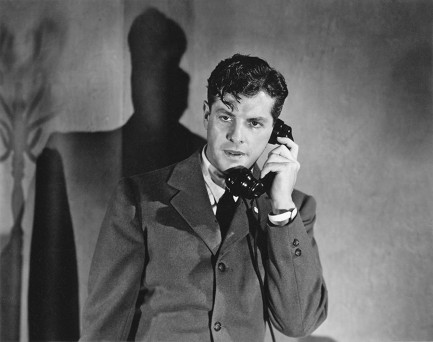 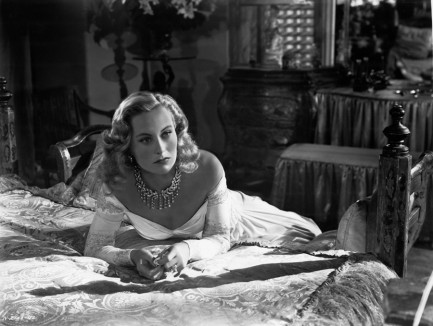 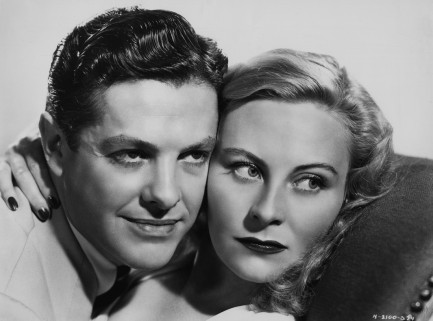 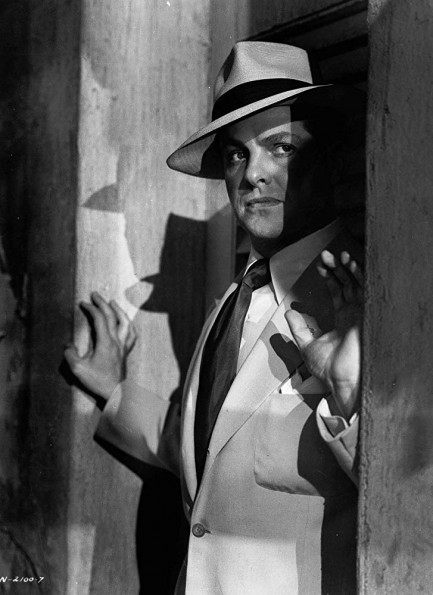 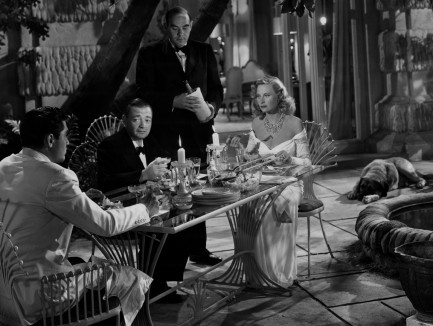 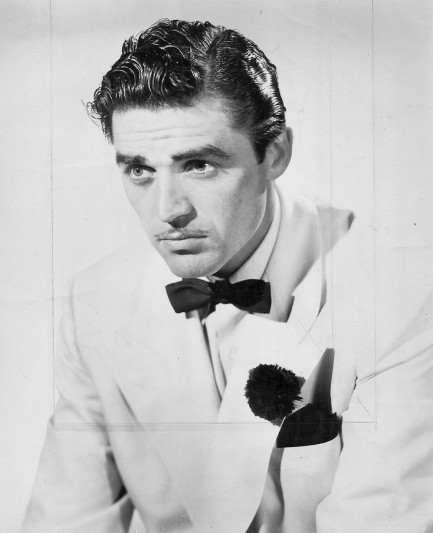 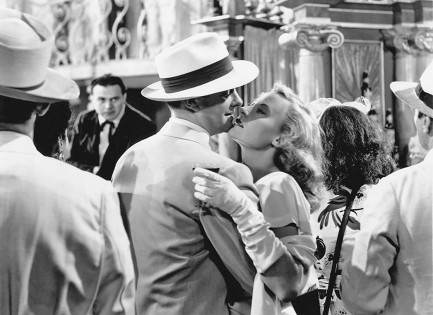 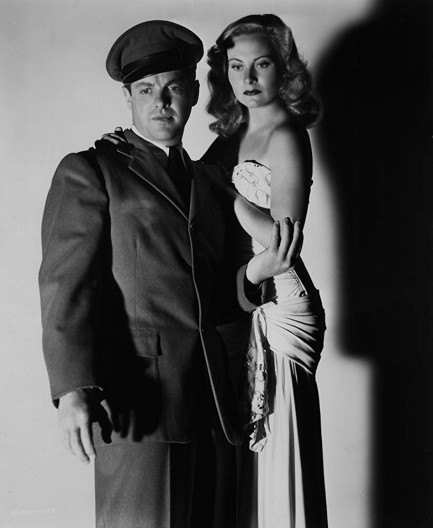 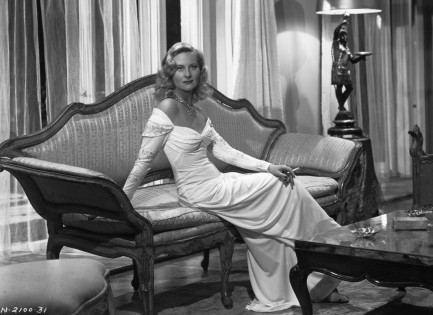 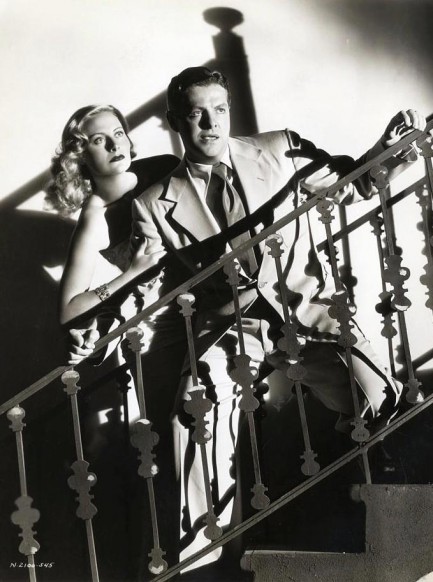
 B-movie actor generates A-list headlines for all the wrong reasons.
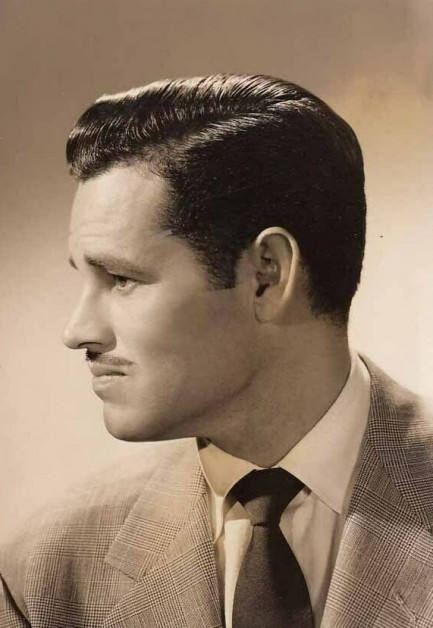 Show business careers go off the rails for a wide array of reasons—lack of talent, lack of audience appeal, substance abuse, and a predilection for general mayhem all come to mind. Hollywood actor Tom Neal fits legendarily into the last category. From his debut in 1938 through 1951 he logged more than seventy film appearances. That's incredible output by any measure. Most of his roles were in b-movies, but there were some notable parts mixed in. His career highlights included Another Thin Man, the film noir Detour, and Crime, Inc. Show business careers go off the rails for a wide array of reasons—lack of talent, lack of audience appeal, substance abuse, and a predilection for general mayhem all come to mind. Hollywood actor Tom Neal fits legendarily into the last category. From his debut in 1938 through 1951 he logged more than seventy film appearances. That's incredible output by any measure. Most of his roles were in b-movies, but there were some notable parts mixed in. His career highlights included Another Thin Man, the film noir Detour, and Crime, Inc.
Neal caused minor scandals early in his career, but he graduated to the majors beginning in early 1951, when he met tempestuous actress Barbara Payton and the two began dating. Payton had announced her engagement the previous year to debonair leading man Franchot Tone, but her ideas about commitment weren't of the standard variety. She was still married to an Air Force Captain named John Payton while dating Tone, and had allegedly slept with Gary Cooper and Steve Cochran while working with them on the 1950 western Dallas. When Neal met her, she kicked Tone to the curb and announced she and Neal would be marrying. But Payton was fickle, to say the least, and ended up dropping Neal and getting re-engaged to Tone. All this while still married to her Air Force guy.
One thing Hollywood people can count on is crossing paths with their colleagues at one point or another—especially if they're dating the same woman. When Neal crossed paths with Tone and Payton in September 1951 at her apartment, he intended to punish the man who had won Payton's hand. Everyone in Hollywood knew Neal had been an amateur boxer. Maybe the qualifier “amateur” gave Tone excessive confidence. Maybe he didn't know that Neal, who you see below with barbells overhead and a tube sock in his shorts, had accumulated a 31-3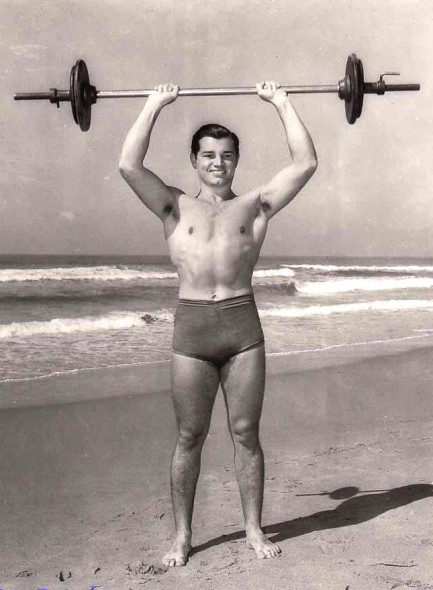 record in the ring. Maybe Tone slipped on a dollop of Beluga caviar. Payton said Tone simply had no choice about fighting because Neal attacked him. Whatever the reason, Neal floored Tone with his first punch, and continued to beat him afterward, delivering cheek and nose fractures. Tone lay in an eighteen hour coma in the hospital. Ironically, that was the day Payton's divorce had come through. record in the ring. Maybe Tone slipped on a dollop of Beluga caviar. Payton said Tone simply had no choice about fighting because Neal attacked him. Whatever the reason, Neal floored Tone with his first punch, and continued to beat him afterward, delivering cheek and nose fractures. Tone lay in an eighteen hour coma in the hospital. Ironically, that was the day Payton's divorce had come through.
1951 had been a pretty good year for Neal up to that point. But from then onward he was Hollywood persona non grata. He'd had more roles in ’51 than he would the entire rest of his career. We wouldn't go so far as saying that means Tone had the last laugh, since it would have been a extraordinarily painful laugh, considering the injuries and cosmetic surgery that followed. But okay, in that karmic way that's never fully satisfying, Tone at least must have felt a bit of Schadenfreude. Neal was blacklisted, and Payton was his. The good times didn't last. He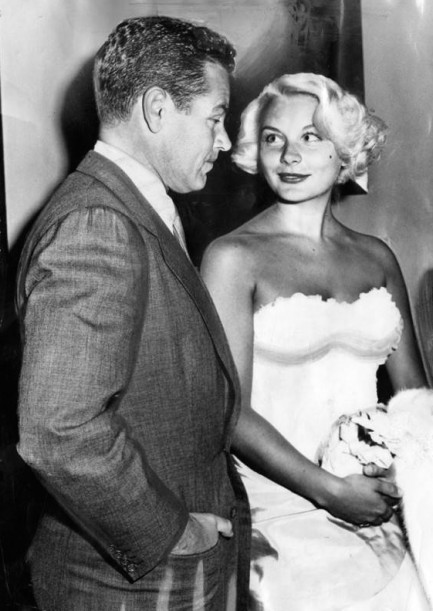 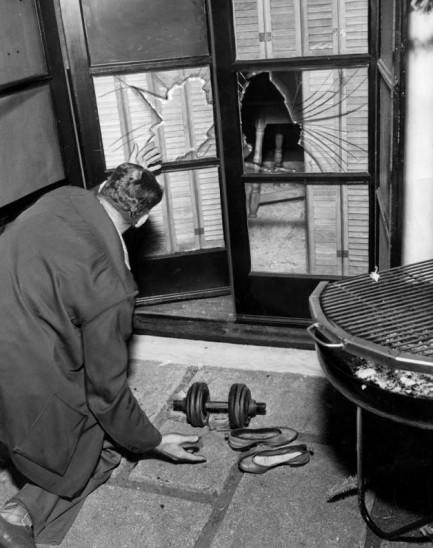 soon discovered that Payton—wait for it—had never stopped seeing Neal, including while Tone was in the hospital with a broken face. So there went that marriage. It seemed as if Neal had unequivocally won Payton's affections after all, and she does look happy in the 1952 photo above, but it's probably no surprise to learn that the two parted ways after a few tumultuous years, some broken windows, and at least one police intervention. Payton went on to have truly epic problems that would put a South American novela to shame. soon discovered that Payton—wait for it—had never stopped seeing Neal, including while Tone was in the hospital with a broken face. So there went that marriage. It seemed as if Neal had unequivocally won Payton's affections after all, and she does look happy in the 1952 photo above, but it's probably no surprise to learn that the two parted ways after a few tumultuous years, some broken windows, and at least one police intervention. Payton went on to have truly epic problems that would put a South American novela to shame.
Neal nursed his severely damaged career along, landing only occasional minor parts, and by the time the ’60s rolled around couldn't beg, barter, or buy a role. He had been married for a few years during the late ’50s, and in 1960 he married again, to a receptionist named Gale (sometimes Gail) Bennett, who you see below. In April 1965 police were summoned to Neal's home in Palm Springs where they found Bennett dead. She had been shot through the back of the head with .45 calibre pistol, the 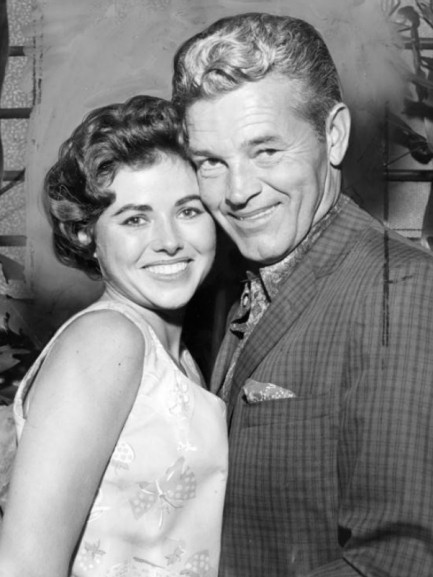 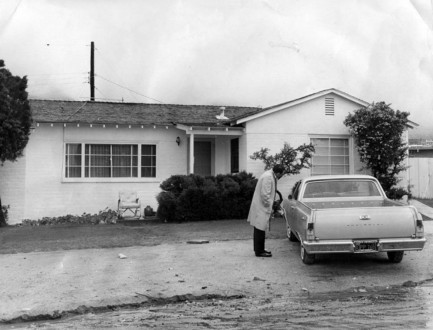 slug entering her skull behind her right ear and ending up in a sofa cushion. Neal wasn't on the premises when police arrived, but was soon arrested, and claimed the shooting had been an accident, the result of a struggle over the gun after his wife pulled it on him. slug entering her skull behind her right ear and ending up in a sofa cushion. Neal wasn't on the premises when police arrived, but was soon arrested, and claimed the shooting had been an accident, the result of a struggle over the gun after his wife pulled it on him.
Accounts of the killing vary, as they always do. In some, Neal shot Bennett as she was taking a nap. In others, they argued. We even found one that said Neal claimed the accident occurred while he and Bennett were making love. At trial Neal's defense attorney claimed a mystery man had pulled the trigger. We were struck, however, when we found that Bennett had secretly filed for divorce, and in the filing specifically mentioned Neal threatening her with a .45 automatic. If that detail struck us, it certainly must have made an impact on the jury. In the end, after a sensational trial, the dozen jurors convicted Neal of involuntary manslaughter.
Neal spent only six years behind bars before being paroled. That's a pretty sweet deal for what many suspected was a clearcut case of premeditated murder. Also, note that during the dust-up with Tone, one witness said Neal threw more than thirty punches after Tone was down. That could be construed as attempted murder, were you inclined to put a label on it, and if that was the plan it almost worked. Doctors thought for a while Tone would never awaken. Neal was a rough and tumble fellow, there's little doubt. But looks and a bit of charm will carry you a long way in life. Eventually, though, even those can run dry. Neal died eight months after his release from prison, aged fifty-eight, of heart failure, looking a shell of his former self.
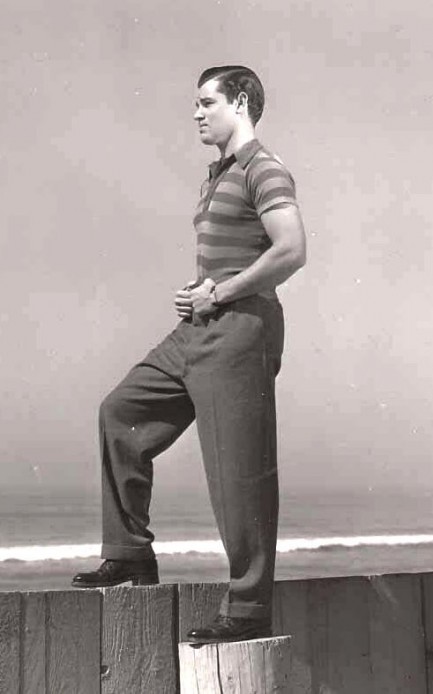 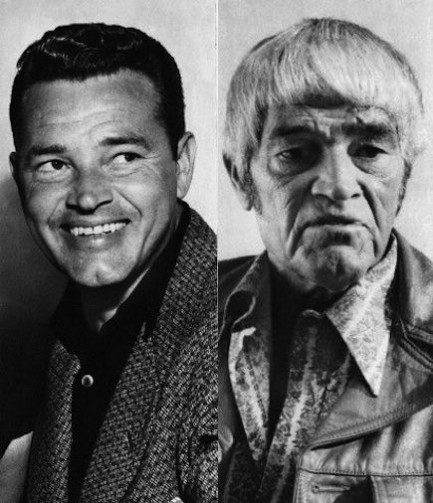
 We'd to hate to find out what the other thirty-five are like. 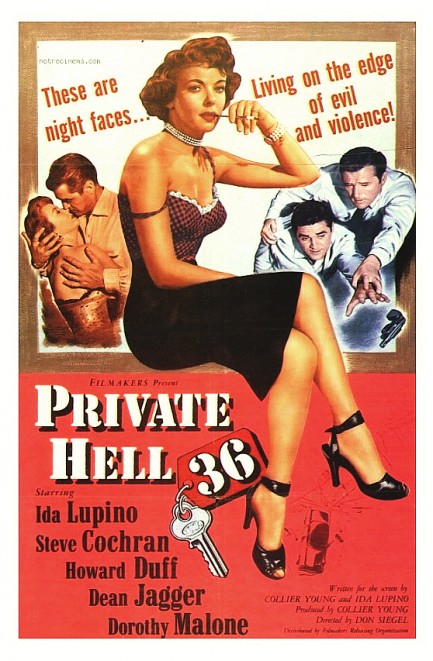 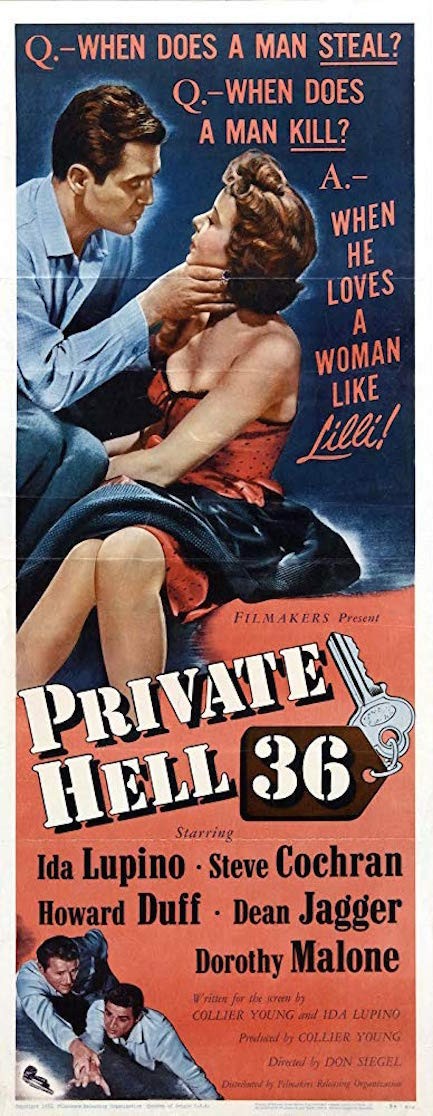
Private Hell 36. It doesn't mean anything, but what a great title. And it comes with two great promo posters. These are probably in the first two chambers of hell to lure you in. Made in 1954, this film noir co-stars and was co-written by Ida Lupino, who plays a woman who is convinced to help the police on a stakeout for a counterfeiter. She'd been passed a fake fifty but the police can't identify the crook unless she sees him and fingers him. As the days pass cop Steven Cochran takes a liking to her, and she to him. Star-crossed love in the noirish night. Lupino wants the finer things in life. Cochran wants to give them to her. When counterfeit bills start blowing on the wind, Cochran and his partner split over stealing the cash. You know where this goes—nowhere good.
Cochran is really good in this. As his decisions hurt those around him and his circumstances constrict his possibilities in the worst way, the performance he gives generates tension and empathy. Lupino does her usual great job, and the support from Dorothy Malone and Howard Duff is perfect, so in the end what you have is a solid film noir tinged with affecting interpersonal drama and working class pathos. In real life we don't feel the least bit bad for dirty cops, but that's the beauty of art—it puts you in other people's shoes and for an hour or two you understand. Private Hell 36 is short and to the point. It asks: If $80,000 landed in your lap would you keep it? In film noir, you better not. 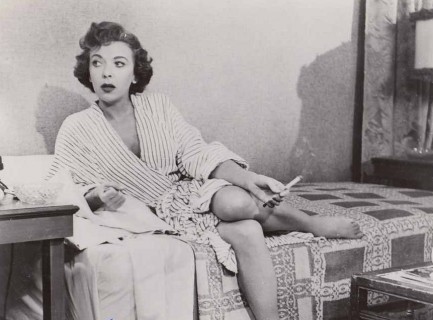 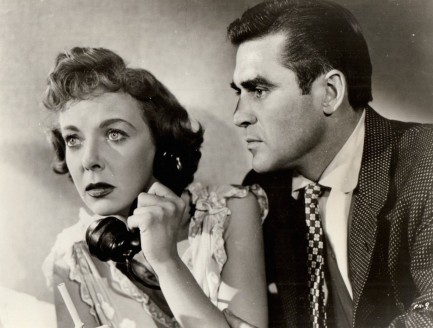 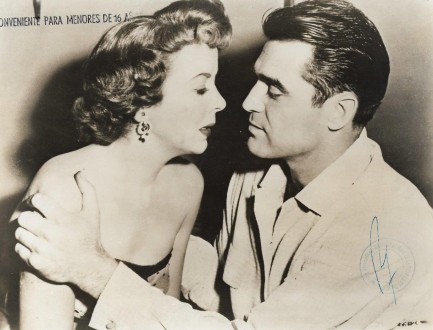 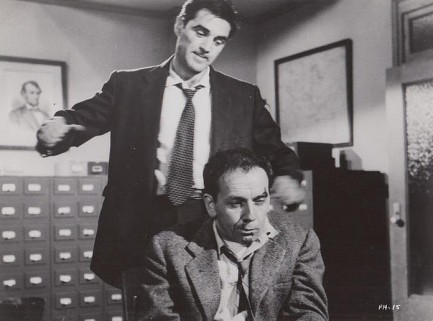 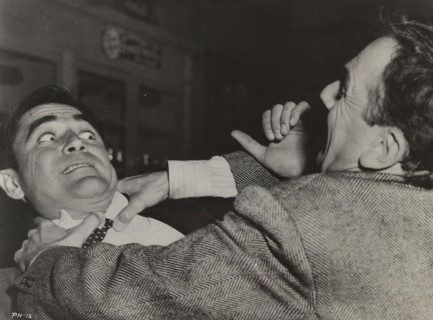 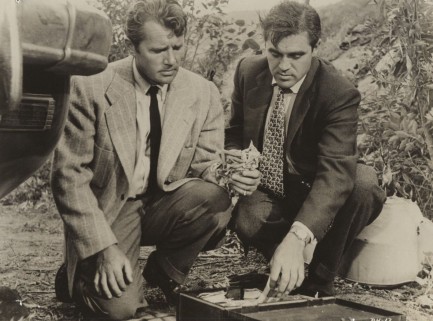 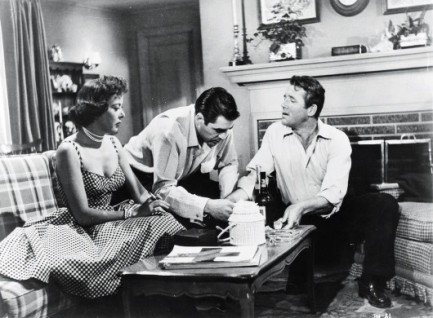 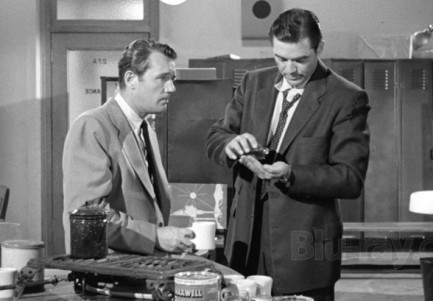 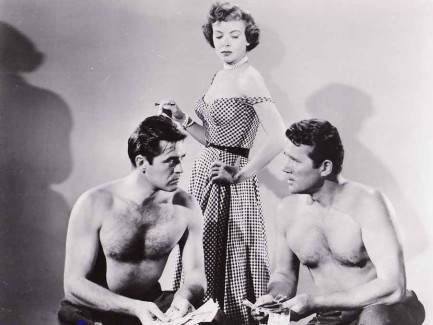
 She was a material girl living in a material world. 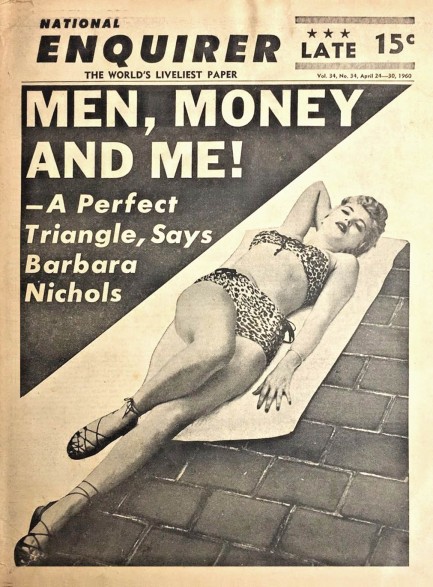
Above is a 1960 National Enquirer with Barbara Nichols on the cover, and editors claiming she said “men, money, and me” make a perfect triangle. Nichols was never a top star, mainly guest starring on dozens of television shows, but she was a staple in tabloids because she dated many rich and famous men but never married, which is why we suspect Enquirer editors came up with their cover quote. Some of her escorts included Jack Carter, Steve Cochran, Cesar Romero, and Elvis Presley. Nichols died in 1976 aged forty-seven due to liver dysfunction. It had initially been torn in an auto accident a decade earlier and gave her problem the rest of her life. We have a pair of nice femme fatale photos of her and you can see those here, and well as an awesome album sleeve here.
 Mamie Van Doren makes her mark on a Generation. 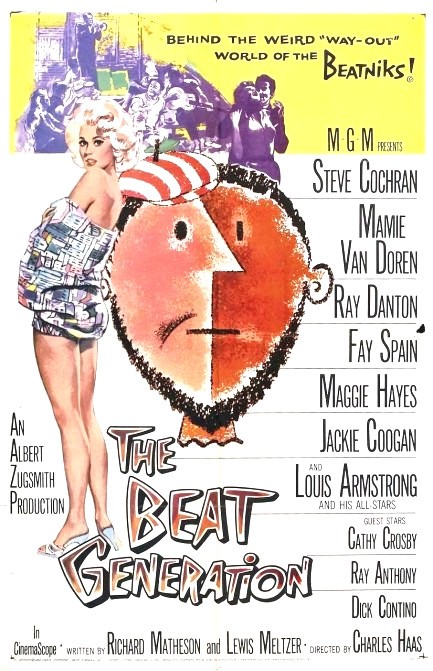
We think this is a beautiful promo poster for The Beat Generation, but don't let its colorful nature fool you—the movie is surprisingly dark. It uses the beatnik counterculture as a backdrop, but really has nothing to with it, except to belittle it. Steve Cochran plays a Los Angeles detective chasing after a serial rapist. Through a random encounter, the rapist becomes aware of Cochran and decides to make his wife a victim. Will he get away with it? You'll have to watch the film. We can tell you its most dramatic aspect involves whether a rape victim can obtain an abortion. The never explored details of how she plans to do it don't matter, because we know she'll change her mind. You can't blame the movie for being predictable in that respect, though. How else was it going to go in the 1950s? The main thing to keep in mind about The Beat Generation is that it was mismarketed—deliberately, we suspect—to trick younger cinemagoers into forking over their cash for a Trojan horse message movie. We're not big fans of that sort of chicanery, but it's well produced, reasonably good, and as a bonus features Fay Spain, Irish McCalla, Robert Mitchum's brother Jim, and Steve Cochran's chest hair. The Beat Generation premiered in the U.S. today in 1959.
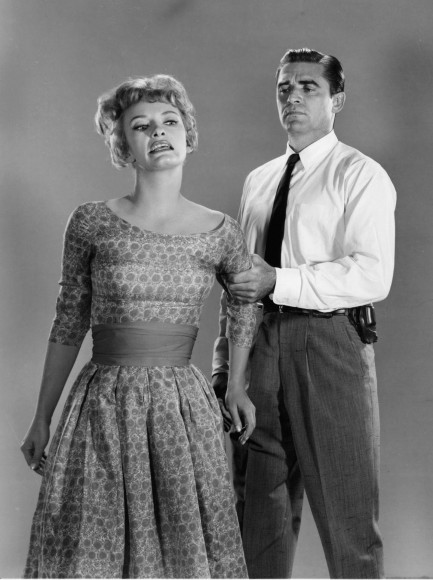 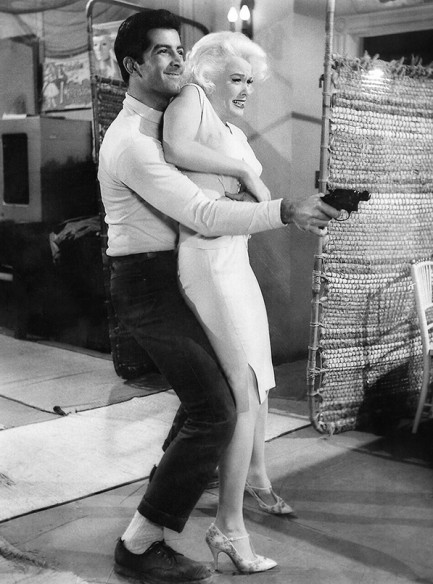 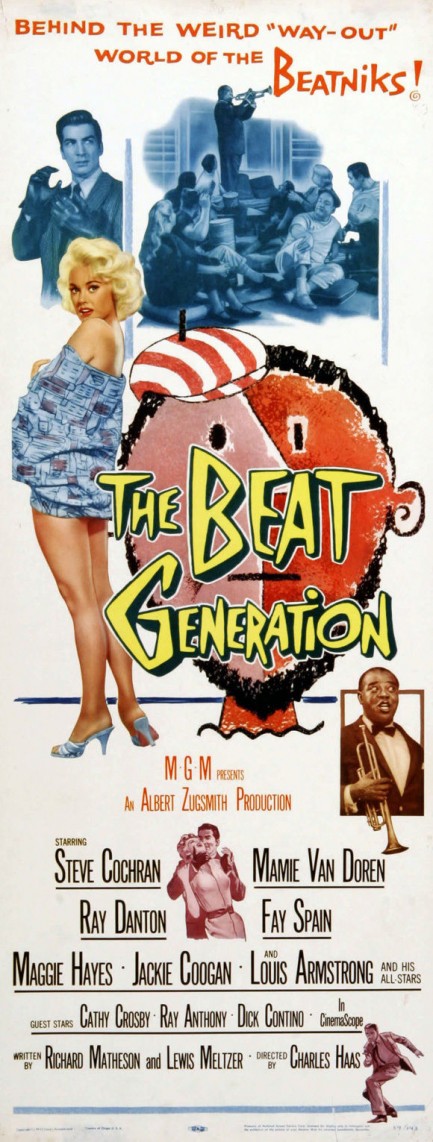

|
 |

The headlines that mattered yesteryear.
1945—Churchill Given the Sack
In spite of admiring Winston Churchill as a great wartime leader, Britons elect
Clement Attlee the nation's new prime minister in a sweeping victory for the Labour Party over the Conservatives. 1952—Evita Peron Dies
Eva Duarte de Peron, aka Evita, wife of the president of the Argentine Republic, dies from cancer at age 33. Evita had brought the working classes into a position of political power never witnessed before, but was hated by the nation's powerful military class. She is lain to rest in Milan, Italy in a secret grave under a nun's name, but is eventually returned to Argentina for reburial beside her husband in 1974. 1943—Mussolini Calls It Quits
Italian dictator Benito Mussolini steps down as head of the armed forces and the government. It soon becomes clear that Il Duce did not relinquish power voluntarily, but was forced to resign after former Fascist colleagues turned against him. He is later installed by Germany as leader of the Italian Social Republic in the north of the country, but is killed by partisans in 1945. 1915—Ship Capsizes on Lake Michigan
During an outing arranged by Western Electric Co. for its employees and their families, the passenger ship Eastland capsizes in Lake Michigan due to unequal weight distribution. 844 people die, including all the members of 22 different families. 1980—Peter Sellers Dies
British movie star Peter Sellers, whose roles in Dr. Strangelove, Being There and the Pink Panther films established him as the greatest comedic actor of his generation, dies of a heart attack at age fifty-four.
|

|
|

It's easy. We have an uploader that makes it a snap. Use it to submit your art, text, header, and subhead. Your post can be funny, serious, or anything in between, as long as it's vintage pulp. You'll get a byline and experience the fleeting pride of free authorship. We'll edit your post for typos, but the rest is up to you. Click here to give us your best shot.

|
|



 Diana Dors smacks Patrick Allen blurry in 1957's The Long Haul.
Diana Dors smacks Patrick Allen blurry in 1957's The Long Haul. Mob boss George Raft menaces Anne Francis in a promo image made for 1954's Rogue Cop.
Mob boss George Raft menaces Anne Francis in a promo image made for 1954's Rogue Cop. Bud Abbott gets aggressive with Lou Costello in 1945's Here Come the Co-Eds.
Bud Abbott gets aggressive with Lou Costello in 1945's Here Come the Co-Eds. Jo Morrow takes one from black hat Jack Hogan in 1959's The Legend of Tom Dooley.
Jo Morrow takes one from black hat Jack Hogan in 1959's The Legend of Tom Dooley. Chris Robinson and Anita Sands get a couple of things straight about who's on the yearbook committee in Diary of High School Bride.
Chris Robinson and Anita Sands get a couple of things straight about who's on the yearbook committee in Diary of High School Bride. Paul Newman and Ann Blyth agree to disagree in 1957's The Helen Morgan Story.
Paul Newman and Ann Blyth agree to disagree in 1957's The Helen Morgan Story. Verna Lisi shows Umberto Orsini who gives the orders in the 1967 film La ragazza e il generale, aka The Girl and the General.
Verna Lisi shows Umberto Orsini who gives the orders in the 1967 film La ragazza e il generale, aka The Girl and the General. What the fuck did you just call me? Marki Bey slaps Betty Anne Rees loopy in the 1974 horror flick Sugar Hill.
What the fuck did you just call me? Marki Bey slaps Betty Anne Rees loopy in the 1974 horror flick Sugar Hill. Claudia Cardinale slaps (or maybe punches—we can't remember) Brigitte Bardot in the 1971 western Les pétroleuses, known in English for some reason as The Legend of Frenchie King.
Claudia Cardinale slaps (or maybe punches—we can't remember) Brigitte Bardot in the 1971 western Les pétroleuses, known in English for some reason as The Legend of Frenchie King. Audrey Totter reels under the attentions of Richard Basehart in 1949 Tension. We're thinking it was probably even more tense after this moment.
Audrey Totter reels under the attentions of Richard Basehart in 1949 Tension. We're thinking it was probably even more tense after this moment. Anne Baxter tries to no avail to avoid a slap from heel Steve Cochran in 1954's Carnival Story.
Anne Baxter tries to no avail to avoid a slap from heel Steve Cochran in 1954's Carnival Story.
 Though Alan Ladd was a little guy who Gail Russell probably could have roughed up if she wanted, the script called for him to slap her, and he obeyed in the 1946 adventure Calcutta.
Though Alan Ladd was a little guy who Gail Russell probably could have roughed up if she wanted, the script called for him to slap her, and he obeyed in the 1946 adventure Calcutta. Peter Alexander guards his right cheek, therefore Hannelore Auer crosses him up and attacks his left in 1964's Schwejk's Flegeljahre, aka Schweik's Years of Indiscretion.
Peter Alexander guards his right cheek, therefore Hannelore Auer crosses him up and attacks his left in 1964's Schwejk's Flegeljahre, aka Schweik's Years of Indiscretion. Elizabeth Ashley gives Roddy McDowall a facial in in 1965's The Third Day.
Elizabeth Ashley gives Roddy McDowall a facial in in 1965's The Third Day. Tony Anthony slaps Lucretia Love in 1972's Piazza pulita, aka Pete, Pearl and the Pole.
Tony Anthony slaps Lucretia Love in 1972's Piazza pulita, aka Pete, Pearl and the Pole. André Oumansky goes backhand on Lola Albright in 1964's Joy House.
André Oumansky goes backhand on Lola Albright in 1964's Joy House. Frank Ferguson catches one from Barbara Bel Geddes in the 1949 drama Caught.
Frank Ferguson catches one from Barbara Bel Geddes in the 1949 drama Caught. This looks like a real slap, so you have to credit the actresses for their commitment. It's from 1961's Raisin in the Sun and shows Claudia McNeil rearranging the face of Diana Sands.
This looks like a real slap, so you have to credit the actresses for their commitment. It's from 1961's Raisin in the Sun and shows Claudia McNeil rearranging the face of Diana Sands. Gloria Grahame finds herself cornered by Broderick Crawford in 1954's Human Desire.
Gloria Grahame finds herself cornered by Broderick Crawford in 1954's Human Desire. Bette Davis, an experienced slapper and slappee, gets a little assistance from an unidentified third party as she goes Old West on Amanda Blake in a 1966 episode of Gunsmoke called “The Jailer.”
Bette Davis, an experienced slapper and slappee, gets a little assistance from an unidentified third party as she goes Old West on Amanda Blake in a 1966 episode of Gunsmoke called “The Jailer.” There are a few slaps in 1939's Gone with the Wind, so we had our pick. We went with Vivien Leigh and Leslie Howard.
There are a few slaps in 1939's Gone with the Wind, so we had our pick. We went with Vivien Leigh and Leslie Howard. Virginia Field takes one on the chin from Marshall Thompson in Dial 1119.
Virginia Field takes one on the chin from Marshall Thompson in Dial 1119. Clint Eastwood absorbs a right cross from nun Shirley MacLaine in 1970's Two Mules for Sister Sara.
Clint Eastwood absorbs a right cross from nun Shirley MacLaine in 1970's Two Mules for Sister Sara.




















 Don't play coy, baby. Would you rather be with a gangsta like me or some accountant from fuckin' donkeyville?
Don't play coy, baby. Would you rather be with a gangsta like me or some accountant from fuckin' donkeyville? That's what I thought.
That's what I thought.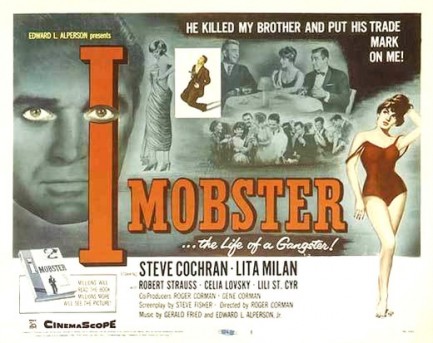














 Show business careers go off the rails for a wide array of reasons—lack of talent, lack of audience appeal, substance abuse, and a predilection for general mayhem all come to mind. Hollywood actor Tom Neal fits legendarily into the last category. From his debut in 1938 through 1951 he logged more than seventy film appearances. That's incredible output by any measure. Most of his roles were in b-movies, but there were some notable parts mixed in. His career highlights included Another Thin Man, the film noir Detour, and Crime, Inc.
Show business careers go off the rails for a wide array of reasons—lack of talent, lack of audience appeal, substance abuse, and a predilection for general mayhem all come to mind. Hollywood actor Tom Neal fits legendarily into the last category. From his debut in 1938 through 1951 he logged more than seventy film appearances. That's incredible output by any measure. Most of his roles were in b-movies, but there were some notable parts mixed in. His career highlights included Another Thin Man, the film noir Detour, and Crime, Inc. record in the ring. Maybe Tone slipped on a dollop of Beluga caviar. Payton said Tone simply had no choice about fighting because Neal attacked him. Whatever the reason, Neal floored Tone with his first punch, and continued to beat him afterward, delivering cheek and nose fractures. Tone lay in an eighteen hour coma in the hospital. Ironically, that was the day Payton's divorce had come through.
record in the ring. Maybe Tone slipped on a dollop of Beluga caviar. Payton said Tone simply had no choice about fighting because Neal attacked him. Whatever the reason, Neal floored Tone with his first punch, and continued to beat him afterward, delivering cheek and nose fractures. Tone lay in an eighteen hour coma in the hospital. Ironically, that was the day Payton's divorce had come through.
 soon discovered that Payton—wait for it—had never stopped seeing Neal, including while Tone was in the hospital with a broken face. So there went that marriage. It seemed as if Neal had unequivocally won Payton's affections after all, and she does look happy in the 1952 photo above, but it's probably no surprise to learn that the two parted ways after a few tumultuous years, some broken windows, and at least one police intervention. Payton went on to have truly epic problems that would put a South American novela to shame.
soon discovered that Payton—wait for it—had never stopped seeing Neal, including while Tone was in the hospital with a broken face. So there went that marriage. It seemed as if Neal had unequivocally won Payton's affections after all, and she does look happy in the 1952 photo above, but it's probably no surprise to learn that the two parted ways after a few tumultuous years, some broken windows, and at least one police intervention. Payton went on to have truly epic problems that would put a South American novela to shame.
 slug entering her skull behind her right ear and ending up in a sofa cushion. Neal wasn't on the premises when police arrived, but was soon arrested, and claimed the shooting had been an accident, the result of a struggle over the gun after his wife pulled it on him.
slug entering her skull behind her right ear and ending up in a sofa cushion. Neal wasn't on the premises when police arrived, but was soon arrested, and claimed the shooting had been an accident, the result of a struggle over the gun after his wife pulled it on him.

























































































